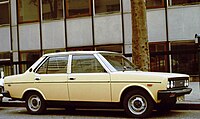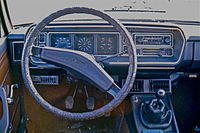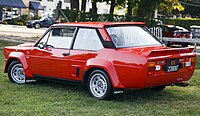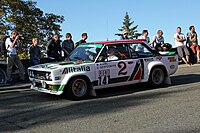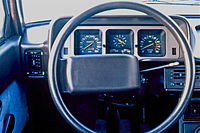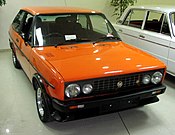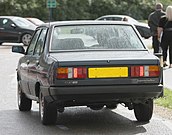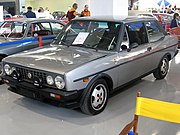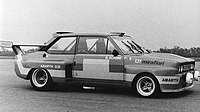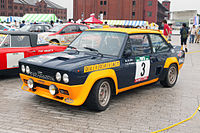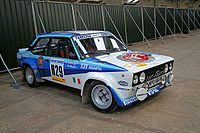Fiat 131
| Fiat 131 | ||
|---|---|---|
Kerb weight 950 to 1,145 kg (2,094 to 2,524 lb) | | |
| Chronology | ||
| Predecessor | Fiat 124 | |
| Successor | Fiat Regata | |
The Fiat 131 is a
.The 131 was also marketed as the Fiat Mirafiori, after the Turin district where the cars were manufactured. Initially, the 131 was offered with 1.3 L and 1.6 L overhead valve engines and the range received revisions in 1978 and 1981. Production reached 1,513,800.[5]
Specifications
The Fiat 131 used
The engines were all
The
The
The car's interior had its secondary dashboard switches illuminated by a central bulb with fibre optic distribution to the switches.
Series 1 (1974–1978)
The Fiat 131 Mirafiori was introduced at the 55th Turin Motor Show in late October 1974.[7] The 131 came with a choice of a 1,297 cc (1.3 L) or 1,585 cc (1.6 L)
The initial range comprised eleven different models.
Initial sales were disappointing, since the car was launched at the height of the
Salvatore Diomante's Autocostruzioni S.D., located near Turin, offered a nearly 5-metre long "131 Diplomatic" limousine conversion.[10]
Model Engine code Engine typeDisplacement
bore × strokeCarburetor Power Mirafiori 1300N 131A6.000[11] I41,297 cc (1.3 L)
75.0 × 71.5 mmsingle twin-choke
Solex C32 TD155 PS DIN (40 kW; 54 hp) at 5000 rpm
(Germany-only version for low octane fuel use)Familiare 1300N Mirafiori 1300 131A.000[12] single twin-choke Weber32 ADF65 PS DIN (48 kW; 64 hp) at 5400 rpm Mirafiori Special 1300 Familiare 1300 Mirafiori 1600 131A1.000[12] 1,585 cc (1.6 L)
84.0 × 71.5 mm75 PS DIN (55 kW; 74 hp) at 5400 rpm Mirafiori Special 1600 Familiare 1600 Familiare Special 1600 Abarth Rally[13] 131AR.000 DOHC16-valve I41,995 cc (2.0 L)
84.0 × 90.0 mmsingle twin-choke
Weber 34 ADF140 PS DIN (103 kW; 138 hp) at 6400 rpm US version 131A1.040 SOHCI41,756 cc (1.8 L) single twin-choke
Weber86 hp SAE net (64 kW; 87 PS)[9]
CA: 83 hp SAE net (62 kW; 84 PS) at 5800 rpm[14]
-
Fiat 131 Mirafiori Special
-
The T-shaped tail lamps are characteristic of first series cars.
-
Series 1 dashboard, here a Mirafiori Special's
-
SEAT 131 Estate
-
US-spec 1976 Fiat 131 four-door, showing the larger bumpers used to meet strict federal safety standards.
Fiat 131 Abarth Rally
In 1976, 400 examples of the Fiat 131 Abarth
The
-
Fiat Abarth 131 Rally
-
Fiat 131 Abarth Rally Stradale; rear view
-
Fiat 131 Abarth Rally Stradale interior
-
Fiat Abarth 131 left side view
-
Walter Röhrl's Fiat 131 Abarth (Sponsor Alitalia)
Series 2 (1978–1981)
The 131 got a minor facelift in 1978. New
Also in 1978, the 2-door sporting version Racing (Mirafiori Sport in the UK) with 115 PS (85 kW) twin cam engine, was launched. This car had four round headlights (the inner headlights being smaller than the outer ones, unlike any other Mirafiori model produced), different grille, spoilers and extended wheel arches, and a short-throw 5 speed gearbox. The Racing had top speed of 180 km/h (110 mph). An important introduction for the Italian and many other continental European markets was the new diesel engined versions, built in Sofim's brand-new factory in Foggia.[17] The diesel had been previewed and tested in competition already, with three diesel-engined cars prepared by Abarth for the 1977 London–Sydney Marathon rally.[17] As introduced on the Series 2, 131 Diesels received four, equally sized round headlights and a noticeable (and characteristic) bump in the hood to accommodate the taller engine. The Familiare (estate) was renamed Panorama.
In Venezuela, the 131 Series 2 was kept in production after the Series 3 had been introduced in Europe. They were only available with the four-door sedan bodywork, as the Mirafiori L and the Mirafiori CL, and were fitted with the Panorama's OHV 1.6-liter engine with 75 PS (55 kW; 74 hp). An additional version was the sporting "131 Corsa 95", which used the 131 Racing's front spoiler, grille, rear spoiler, and other parts (still with four doors) along with the twin cam Supermirafiori engine and a sizable bonnet scoop. In Venezuela, this engine produced a claimed 95 PS (70 kW; 94 hp) at 6000 rpm.[18]
Brava (USA)
The Series 2 was marketed in the United States as the Fiat Brava (two-door only) and Super Brava from mid-year 1978 with the same 1.8 litre four as had been used in the US-market 131, but before the year was over this was replaced by the somewhat more powerful and much torquier 2 litre twin-cam four also seen in the Spider.[19] Initially, the better equipped models were sold as Super Bravas, but the base model and "Super" tag were dropped for 1979. The interim Brava version also retained the 131's interior.[20] Importantly, the air conditioning system was also upgraded to cope with the demands of US drivers. For 1980 a more powerful fuel-injected version was added (102 hp or 76 kW) while the Estate version was dropped. For 1981 the EFI engine became standard equipment and the headlamps were changed for single rectangular units, but this was to be the last year for the Brava/131 in the US.[21] The January 1991, edition of Popular Mechanics in the United States listed the 1979 Fiat 131 in the "Overall Worst" category as the most "trouble prone" car ever recorded in their Owner Report histories.[22]
| Displacement | Engine type | Power | |
| Mirafiori | 1297/1301 cc | I4 ohv | 65 PS (48 kW; 64 hp) |
| Supermirafiori | 1297/1301 cc | I4 dohc | 78 PS (57 kW; 77 hp) |
| Supermirafiori | 1585 cc | I4 dohc | 96 PS (71 kW; 95 hp) |
| Panorama | 1297/1301 cc | I4 ohv | 65 PS (48 kW; 64 hp) |
| Panorama | 1585 cc | I4 ohv | 75 PS (55 kW; 74 hp) |
| Diesel | 1995 cc | I4 | 60 PS (44 kW; 59 hp) |
| Diesel | 2445 cc | I4 | 72 PS (53 kW; 71 hp) |
| Racing | 1995 cc | I4 dohc | 115 PS (85 kW; 113 hp) |
| Brava | 1756 cc | I4 dohc | 83 hp (62 kW; 84 PS)[23] |
| Brava | 1995 cc | I4 dohc | 86 hp (64 kW; 87 PS) CA: 80 hp (60 kW; 81 PS)[24] |
| Brava EFI | 1995 cc | I4 dohc | 103 PS (76 kW; 102 hp)[21] |
-
Fiat 131 Supermirafiori
-
Series 2 dashboard
-
Fiat 131 Racing
-
Fiat 131 Marengo, van version of the 131 Panorama estate
131 Hybrid
In 1979, Fiat presented the 131 Ibrida,[25] an experimental prototype featuring the small 903 cc engine from the Fiat 127, de-tuned to 33 hp (24 kW), and mated to a 24 kW DC electric motor. Power is also provided by regeneration via the braking system. The 250 amp batteries are located in the boot, adding 175 kg (386 lb) to the weight.[26]
Series 3 (1981–1984)
The 131 was updated again in March 1981.[27] By this time, the car was no longer offered in the USA. Production of the Racing/Sport versions ceased, although these were sold well into 1982. The same 2.0 TC (twin cam) engine went to the Supermirafiori. The car was renamed 131 Super Brava in Australia. The car received a slightly updated interior (instruments, single-piece glovebox lid), whilst lower rubbing strips found their way onto all models up to CL specification. The Supermirafiori received larger lower door cladding. Mechanically, Mirafiori versions now received overhead cam engines rather than pushrod versions; a new 1.4 litre engine and a revised 1.6 litre. Also new were the clutch and gearboxes, a tweaked suspension was also introduced and the gas tank increased in size by three litres, for a total 53 L (14.0 US gal; 11.7 imp gal) capacity.
In June 1981, a new sport version, the Volumetrico Abarth, was introduced to some markets, with a supercharged version of the familiar 2-litre
In 1983, the production of the saloon version was discontinued, but the estate, now named 131 Maratea, remained in production with two engine choices (115 PS 2.0 TC and 72 PS 2.5 D) until 1984, when they were replaced with the Ritmo-based Regata Weekend. These last versions featured four round headlights and the by-now familiar five-bar grille.
In Australia the saloon was also updated for a final time for the 1984 model year. It also received the 4 round headlight and five bar grille. Other subtle revisions were also made to the vehicles wiring with the central locking button removed and integrated into central locking motors. Wheels were upgraded to a 14-inch size with unique offset . Driveshaft universal joint size was increased . Steering rack ends and tie rod ends were sizing was also changed. Brake master cylinder bore size was increased to 20mm and brake fittings changed to a metric fine thread size.
| Model | Displacement | Engine type | Power |
| Mirafiori | 1,367 cc | SOHC I4 | 70 PS (51 kW; 69 hp) |
| Mirafiori CL | 1,585 cc | SOHC I4 | 85 PS (63 kW; 84 hp) |
| Supermirafiori | 1,367 cc | DOHC I4 |
75 PS (55 kW; 74 hp) |
| Supermirafiori | 1,585 cc | DOHC I4 | 98 PS (72 kW; 97 hp) |
| Supermirafiori | 1,995 cc | DOHC I4 | 115 PS (85 kW; 113 hp) |
| Volumetrico Abarth | 1,995 cc | DOHC I4 | 140 PS (103 kW; 138 hp) |
| Panorama | 1,301 cc | OHV I4 | 65 PS (48 kW; 64 hp) |
| Panorama | 1,585 cc | SOHC I4 | 85 PS (63 kW; 84 hp) |
| Mirafiori 2000 Diesel | 1,995 cc | I4 | 60 PS (44 kW; 59 hp) |
| Mirafiori 2500 Diesel | 2,445 cc | I4 | 72 PS (53 kW; 71 hp) |
| Supermirafiori 2500 Diesel |
-
Profile of a 131 Supermirafiori Diesel 2500
-
Fiat 131 Supermirafiori, rear view
-
Fiat 131 Volumetrico Abarth
Motorsport
The 131 as a rally car
Fiat 131 Rally's precursor the 3.5-litre
Between 1975 and 1977 the official "works" cars carried the Olio Fiat blue and yellow
Prior to the introduction of the 131 Diesel, Fiat had Abarth prepare three diesel-engined cars with two-door, Series 1 bodyshells for the 1977 London–Sydney Marathon rally to promote its reliability and robustness.[17] Entered by the French Esso Aseptogyl team, two cars finished, in 15th and 23rd place. The engines were largely unmodified, while the cars were fitted with 5-speed gearboxes and 90-litre (20 imp gal) fuel tanks.[17]
-
1975 "031", Fiat Abarth 131's pre-series racing prototype.
-
Giorgio Pianta's Fiat Abarth 031, in action at the Imola stage of 1975 Giro d'Italia.
-
Fiat Abarth 131 rally car with "Olio Fiat" livery
-
Fiat Abarth 131 rally car with "Alitalia" livery
-
Fiat Abarth 131 rally car with "Wreath Fiat" livery
World Rally Championship event victories
Fiat Abarth 131s recorded victories in the following World Rally Championship events:
Other motorsports
In 1978, American actor James Brolin campaigned a Fiat 131 Abarth on a limited schedule in the GTU category of the IMSA GT Championship. The car carried sponsorship from Anheuser-Busch Natural Light beer, which had been introduced the previous year.
Non-Italian 131 variations
SEAT 131

The SEAT 131 started its production in early 1975 in Barcelona with two versions initially offered: SEAT 131 L, featuring rectangular front lamps, 1,438 cc OHC engine and 4 speed gearbox and SEAT 131 E featuring four round headlamps, 1,592 cc DOHC engine and 5 speed gearbox. The range grew up in 1976 with the SEAT 131 Familiar, estate version offered with both engines. In 1977 the 131 Automatico (Automatic gearbox) was released and the following year a very short production of the SEAT 131 CLX 1800 was offered.
In 1978, the SEAT 131 evolved into the SEAT 131 Mirafiori/Supermirafiori (Panorama for the estate versions), with the same changes as seen on its Italian cousin. The engines remained largely the same, but a 1.8 litre Diesel Perkins 4.108 engine was available in 1979.
A further CLX special edition was launched in 1980. Available only in metallic silver or metallic bronze colours, this 131 CLX had a 1,919 cc engine, developing 114 PS (84 kW) at 5,800 rpm.[31]
In 1981, the Diesel version was developed with a new Sofim engine. This 2,500 cc engine was much more powerful than the Perkins version (72 hp against only 49 hp) and was one of the most successful taxis in early '80s Spain.
In 1982, the SEAT 131 changed again, gathering all the body changes seen on the Fiat 131 series 3. The 131 was now available in CL, Supermirafiori and Diplomatic versions. The Diplomatic was the top of the range, with a 1,995 cc engine and features such as power steering, power windows or air conditioning. The Panorama versions were the cars chosen by the "Cuerpo Nacional de Policia" (Spanish Police force) as patrol cars.
In 1984, the SEAT 131 range was discontinued, without a direct substitute and the Fiat Ritmo-based SEAT Málaga took its place in 1985.
Murat 131
Turkish Automotive Factories Incorporated (Tofaş) in Turkey started the production of Fiat 131s built under Fiat license with the Murat 131 (Turkish: Desire) nameplate. Later, Fiat 131 based "Bird Series" were developed and built in Bursa, Turkey. The base version of "Bird Series" was named as Murat 131 Şahin (Turkish: Hawk), luxury version was as Murat 131 Doğan (Turkish: Falcon) and the estate version was named as Murat 131 Kartal (Turkish: Eagle). These vehicles enjoyed a very long production run (1986–2002 at Turkey, 1991–2009 at Egypt, 2006–2010 at Ethiopia), and were later replaced by newer Fiat models.
Polski Fiat 131p
Assembly of the 131 sedan was also undertaken in Poland by Fabryka Samochodów Osobowych (FSO) in the years 1975 to 1981, and 3102 were assembled in total.[32] They were often used by state institutions and communist party officials.[32] First series cars were available only in Special trim and were called Polski Fiat 131p Mirafiori. Cars of second series were known under the name Fiat 131p Mirafiori and were offered in L and CL trim levels.
Other producers
The Fiat 131 was also produced at
Other CKD production of the Fiat 131 has taken place in the following countries:[33]
- Córdoba; Argentina, FIAT Córdoba.
- Bogotá, Colombia; (Compañía Colombiana Automotriz).
- San José, Costa Rica (S.A.V.A.).
- Jakarta, Indonesia (P.T. Daha Motor, Saloon and Station Wagon).[2]
- Kuala Lumpur, Malaysia.[34]
- Casablanca, Morocco (SOMACA).
- Lisbon, Portugal (Fiat Portuguesa SARL, Somave Sarl[35])
- Singapore (Sharikat Fiat Distributors).
- Bangkok, Thailand (Karnasuta General Assembly Co.).
- Caracas, Venezuela (FIAT de Venezuela C.A.).
- Livingstone, Zambia (Livingstone Motor Assemblers Ltd)
References
- ^ Los años tenebrosos del sector automotor: 1982, El "Boom" de los Importados: Los años tenebrosos del sector automotor: 1982, El "Boom" de los Importados, accessdate: 12. July 2019
- ^ ISBN 88-7212-012-8.
- ^ "Somaca Casablanca". Somaca.e-monsite.com. Archived from the original on 20 May 2015. Retrieved 19 April 2010.
- ^ "FSO Warsaw". fso-sa.com.pl. 22 November 2011. Archived from the original on 9 February 2015. Retrieved 22 November 2011.
- ^ a b "Fiat 131". carsfromitaly.net. Retrieved 3 October 2007.
- ^ a b Auto Katalog 1983. Stuttgart: Vereinigte Motor-Verlage GmbH & Co. KG. 1982. pp. 220–221.
- ^ a b c d Villare, Renzo (30 October 1974). "Queste le undici versioni della Fiat "131 mirafiori"" [These are the eleven Fiat "131 mirafiori" variants]. La Stampa (in Italian). p. 13. Retrieved 15 November 2015.
- ^ Quattroruote: Tutte le Auto del Mondo 77/78. Milano: Editoriale Domus S.p.A. 1977. pp. 191–194.
- ^ ISBN 0-87341-158-7.
- ^ Costa, André; Fraichard, Georges-Michel, eds. (1981). "Salon 1981: Toutes les Voitures du Monde". L'Auto Journal (in French) (14–15). Paris: 200.
- ^ Technische Tabellen: Fiat 131/1300 (in German), Fiat Kundendienst, January 1975, archived from the original on 30 January 2024 – via italo-youngtimer.de
- ^ a b Fiat 131 Mirafiori—Uso e manutenzione (owner's manual) (in Italian). Fiat. November 1974.
- ^ "Fiat Abarth 131 Rally—La guida pesante" [Heavyweight driving]. Autosprint (in Italian). XVI (12): 52–54. 12 March 1976.
- ^ "Fiat 131: Larger and more practical, but still sporty". Road & Track. Vol. 27, no. 3. October 1975. p. 47. Archived from the original on 28 October 2023 – via Curbside Classic.
- ISBN 978-1-84584-182-9.
- ^ "1978 Fiat Abarth 131 Rally". automobile-catalog. Retrieved 8 July 2018.
- ^ a b c d "Fiat 131 Mirafiori: da 3 anni è un successo" [Fiat 131 Mirafiori: a three-year success]. Quattroruote: Tutte le Auto del Mondo 77/78 (in Italian). Milano: Editoriale Domus S.p.A. 1977. p. 205.
- ^ Quattroruote: Tutte le Auto del Mondo 82/83: AC-Nissan (in Italian). Vol. 1°. Milano: Editoriale Domus S.p.A. 31 October 1982. p. 249.
- ^ Flammang, Standard Catalog of Imported Cars, p. 240
- ^ "Fiat Super Brava: Bravado or Bravura?", Road & Track's Road Test Annual & Buyer's Guide 1979, Greenwich, CT: CBS Publications, p. 139, January–February 1979
- ^ ISBN 978-0873411585.
- ^ Lamb, Michael (January 1991). "Ask the Man Who Owns One "All Time Worst"". Popular Mechanics.
- ^ R&T Buyer's Guide 1979, pp. 140–141
- ^ Braunschweig, Robert; Büschi, Hans-Ulrich, eds. (6 March 1980), Automobil Revue '80 (in German and French), vol. 75, Berne, Switzerland: Hallwag, AG, p. 287
- ^ Kla, Giancarlo Gnepo (15 January 2020). "Fiat 131 ibrida: un'occasione mancata" [Fiat 131 Ibrida: A missed occasion]. Ruoteclassiche (in Italian). Retrieved 13 July 2022.
- ^ Norbye, Jan P. (November 1980). "We drive Fiat's experimental hybrid electric car". Popular Science. Vol. 217, no. 5. pp. 84–86.
- ^ Salon 1981, p. 170
- ^ "The Fiat 131 Supermirafiori Volumetrico Abarth". 131mirafiori.com. Retrieved 29 November 2012.
- ISBN 3-444-06065-3.
- ^ "Walter Röhrl". rallybase.nl. Retrieved 3 July 2007.
- ^ Automobil Revue '80, p. 472
- ^ a b Podbielski, Zdzisław (2019). Samochody montażowe z Żerania, "Auto Świat Classic" Nr 4/2019, p. 136-137 (Polish)
- ^ ISBN 0-910714-14-2.
- ^ Tutte le Auto del Mondo 77/78, p. 197
- ISBN 0-910714-16-9.

